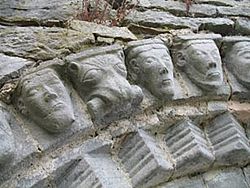Dysert O'Dea Monastery facts for kids

The faces found on the outer arch of the doorway
|
|
| Site | |
|---|---|
| Location | near Corofin, County Clare, Ireland |
| Coordinates | 52°54′33″N 9°04′06″W / 52.909195°N 9.068444°W |
| Public access | yes |
| Official name | Dysert O'Dea |
| Reference no. | 16 |
Dysert O'Dea Church is a very old place near Corofin in County Clare, Ireland. Its Irish name, Díseart Uí Dheá, means "the hermitage of Deá." A hermitage is a quiet place where a religious person lives alone.
This church is built where an early Christian monastery once stood. People believe Saint Tola started this monastery way back in the 8th century. Most of the buildings you see there today were built much later, around the 12th century. It's a really interesting place to visit!
Contents
Exploring Dysert O'Dea
The old monastery site has several important parts. These include "St. Tola's Church," a tall "round tower," "St. Tola's Well," and "St. Tola's Cross." Each part has its own unique story.
St. Tola's Church
The church stands where the first monastery was founded by Saint Tola. The building you see now is mostly from the 12th century. It is a Romanesque style church, which means it has thick walls and round arches. It is over 30 meters long!
Later, in the early 13th century, new narrow windows were added to the east side. You can also see a stone arch with twelve human faces and seven animal heads carved into it. Inside the church, there is a grave for Joan O'Dea, who was the wife of the last clan leader, Michael O'Dea. Her grave dates back to 1684.
The Round Tower
The round tower at Dysert O'Dea was built in the late 11th century. These towers were often used as bell towers or safe places. In the 16th century, it was changed into a fort.
Sadly, the tower was badly damaged in a battle in 1651. It was hit by cannons! It used to be about 30 meters tall, but now only about a third of it remains. In 1790, an old bronze bell was found here. It was sold to help pay for the bell in the current local church. Later, in the 1850s, a local landlord named Edward Synge helped repair the tower.
St. Tola's Well
St. Tola's Well is a very old well, even older than Christianity in Ireland! People used to visit it every year on March 30th as part of a special journey. In the 1860s, the landlord covered the well. But it was opened up again in 1986, so people can see it once more.
St. Tola's Cross
A tall stone cross, called "St. Tola's Cross," is located in a field near the church. It was made in the 12th century. The top part of the cross shows a carving of Jesus on the cross. Below that, there is a figure of a bishop. The back and sides of the cross have beautiful Irish patterns woven together.
This cross was knocked over by soldiers in the 1600s. But Michael O'Dea fixed it in 1683. He used stones from the church to build its base, which means the church was probably not being used much by then. The Synge family also helped restore the cross in 1871. In 1960, the cross was even taken apart and sent to Spain for an art show!
Nearby Historical Sites
Dysert O'Dea is part of the Dysert O'Dea Archaeological Trail. This means there are many other cool historical spots close by. You can find O'Dea Castle, two old ring forts (circular forts), the remains of an ancient cooking site called a fulacht fiadh, and the ruins of a stone Victorian house from 1861.
"Synge's Lodge" is a ruined guest house built in the old Georgian style not far from the church. Above its door, you can still see the Synge family's symbol and their motto. The family's local agent lived in "Mollaneen House," built around 1780. This house had a special garden with walls and an orchard for fruit trees.
A famous battle, the Battle of Dysert O'Dea, happened near this monastery site in 1318.
Dysert O'Dea Today
Today, the church, round tower, and high cross are all protected as a National Monument of Ireland. This means they are very important historical sites that are looked after by the country.
Gallery
See also
 In Spanish: Monasterio de Dysert O'Dea para niños
In Spanish: Monasterio de Dysert O'Dea para niños







